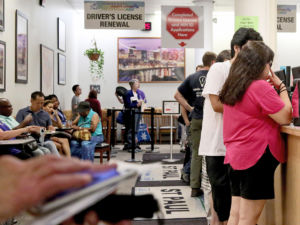State Wants to Raid REAL ID Funding to Fix Botched Registration System
 The more things change, the more they stay the same. That should be the tagline for MNIT, the state agency responsible for development and implementation of the disastrous vehicle and registration system that still doesn’t work, despite being tens of millions of dollars over budget and years behind schedule. No wonder some Republican lawmakers want to disband the troubled tech agency once and for all.
The more things change, the more they stay the same. That should be the tagline for MNIT, the state agency responsible for development and implementation of the disastrous vehicle and registration system that still doesn’t work, despite being tens of millions of dollars over budget and years behind schedule. No wonder some Republican lawmakers want to disband the troubled tech agency once and for all.
Now MNIT plans to divert millions more taxpayer dollars from the mission critical REAL ID driver’s license program and use it to prop up the failing MNLARS vehicle registration system, according to the Pioneer Press.
The likely solution floated this week to state lawmakers aims to keep improving MNLARS — the now-$100-million-plus computer system that was rolled out more than a year ago and has never worked as it was supposed to — through February by diverting $5.5 million from the Real ID track.
Commissioner Johanna Clyborne, who heads the state information technology department, or MNIT, told lawmakers and the Pioneer Press that the planned use of the $5.5 million in Real ID funds will delay enhancements to that system, but it won’t affect the underlying launch of the new licenses Oct. 1.
After February, work on MNLARS would essentially cease without new funding from the next Legislature and governor. A more-secure funding plan failed at the Capitol earlier this year. It became roadkill when it was included in a wide-ranging spending bill that Republican lawmakers passed and Gov. Mark Dayton, a Democrat, vetoed for unrelated reasons. Each side blamed the other.
There’s a lengthy and always expensive to-do list of fixes needed to keep the Dayton Administration’s Exhibit A in government incompetence from imploding altogether. The nuts and bolts that should have been in place from day one.
Implicit in the plan is that MNIT and the Department of Public Safety, which administers tabs and titles, will have to ask lawmakers for additional money early in the winter — a dicey proposition. The Legislature convenes in January and generally doesn’t approve funding until the spring.
However, last year the agency received a similar “emergency” appropriation to keep the fixes coming, and both Clyborne and [Chair of the House Transportation Fianance Committee Rep. Paul] Torkelson, noted that this request should come as no surprise.
Clyborne said it’s too early to tell how much money will be needed. The original MNLARS system cost $93 million, and pretty much everything since the launch in August 2017 has been extra. When all is said and done, it seems unlikely the final price tag would be below $130 million. And that’s not including likely reimbursements to license centers, which have suffered financial losses, and potential refunds to customers who have overpaid. At least one attorney is exploring a possible lawsuit.
The temporary fix may be inevitable, since MNIT can proceed without legislative approval. But Republican resistance to throwing more good taxpayer money after bad remains fierce.
“I am again disappointed by the decisions being made around the colossal failure of MNLARS and the disastrous implementation,” Assistant Majority Leader Rep. Jim Nash, R-Waconia told American Experiment.
“To rob Peter to pay Paul is another potentially grave error made by the Dayton Administration and MN.IT leadership. This will potentially put Real ID in jeopardy as we inch towards the go live date for that.”
And if that’s not unsettling enough, consider this. The Dayton Administration still hasn’t provided a deadline or estimate of what it will cost to make MNLARS the state-of-the-art system it was supposed to be. Hold your pocketbook, but don’t hold your breath.